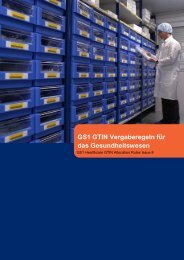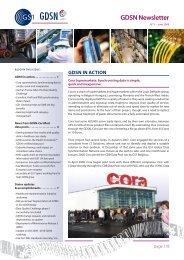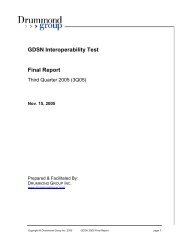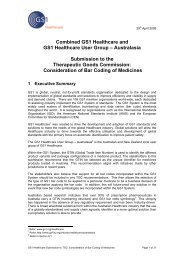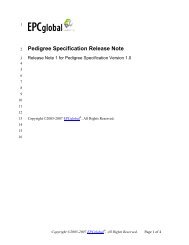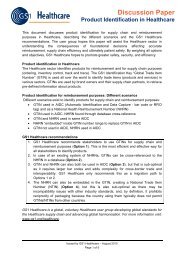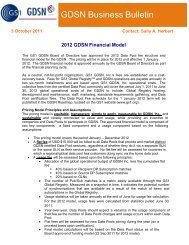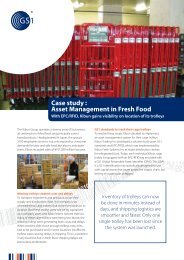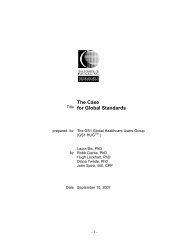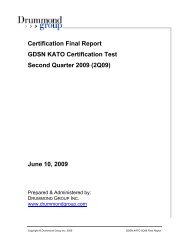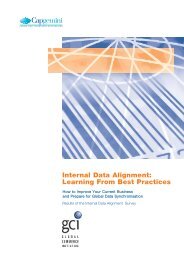SBDH Technical Implementation Guide - GS1
SBDH Technical Implementation Guide - GS1
SBDH Technical Implementation Guide - GS1
Create successful ePaper yourself
Turn your PDF publications into a flip-book with our unique Google optimized e-Paper software.
Standard Business Document Header (<strong>SBDH</strong>) Version 1.3 - <strong>Technical</strong> <strong>Implementation</strong> <strong>Guide</strong><br />
The value for DocumentIdentification/Type SHALL be set according to the following table, which<br />
specifies a value for this field based on the kind of EPCIS document and the context in which it is<br />
used.<br />
Document Type and Context<br />
EPCISDocument used in any context<br />
EPCISMasterData used in any context<br />
EPCISQueryDocument used as the request side of the<br />
binding in Section 11.3<br />
EPCISQueryDocument used as the response side of the<br />
binding in Section 11.3<br />
EPCISQueryDocument used in any XML binding of the<br />
Query Callback interface (Sections 11.4.2 – 11.4.4)<br />
EPCISQueryDocument used in any other context<br />
Value for DocumentIdentification/Type<br />
Events<br />
MasterData<br />
QueryControl-Request<br />
QueryControl-Response<br />
QueryCallback<br />
Query<br />
The AS2 binding for the Query Control Interface (Section 11.3) also specifies additional Standard<br />
Business Document Header fields that must be present in an EPCISQueryDocument instance used as<br />
a Query Control Interface response message.<br />
In addition to the fields specified above, the Standard Business Document Header SHALL include all<br />
other fields that are required by the <strong>SBDH</strong> schema, and MAY include additional <strong>SBDH</strong> fields. In all<br />
cases, the values for those fields SHALL be set in accordance with <strong>SBDH</strong>. An industry group MAY<br />
specify additional constraints on <strong>SBDH</strong> contents to be used within that industry group, but such<br />
constraints SHALL be consistent with the specifications herein.<br />
5. Additional Information<br />
5.1. International telephone number format<br />
The [<strong>SBDH</strong>] elements ‘FaxNumber’ and ‘TelephoneNumber’, currently should be formatted in a way<br />
that is commonly agreed upon or understood between the ‘Sender’ and ‘Receiver’ party. It is a<br />
common practice to format the number using a local format. To further improve the interoperability and<br />
clarity of contact information data an international standard format for telephone number should be<br />
used. The International Telecommunications Union (ITU) and the Internet Engineering Task Force<br />
(IETF) ‘de jure’ standards bodies have a standard/recommendation on the format to be used for<br />
telephone numbers. Although, this implementation guide refrains from standardizing any rules for<br />
telephone number format, optionally it is recommended that the URI format for telephone numbers as<br />
specified in [RFC3966] should be used. [RFC3966] is based upon [ITU-T E.123] which is used as the<br />
starting point for standardization of telephone number formats. A URI notation adds more specificity<br />
and clarity and is more recognizable by software as it standardizes the telephone number string in a<br />
machine and human readable format.<br />
Examples:<br />
■ tel:+1-201-555-0123: This URI points to a phone number in the United States. The hyphens<br />
are included to make the number more human readable; they separate country, area code<br />
and subscriber number.<br />
■<br />
tel:7042;phone-context=example.com: The URI describes a local phone number valid within<br />
the context "example.com".<br />
July-2007, Issue 1 All contents copyright © <strong>GS1</strong> 2007 Page 16 of 21




